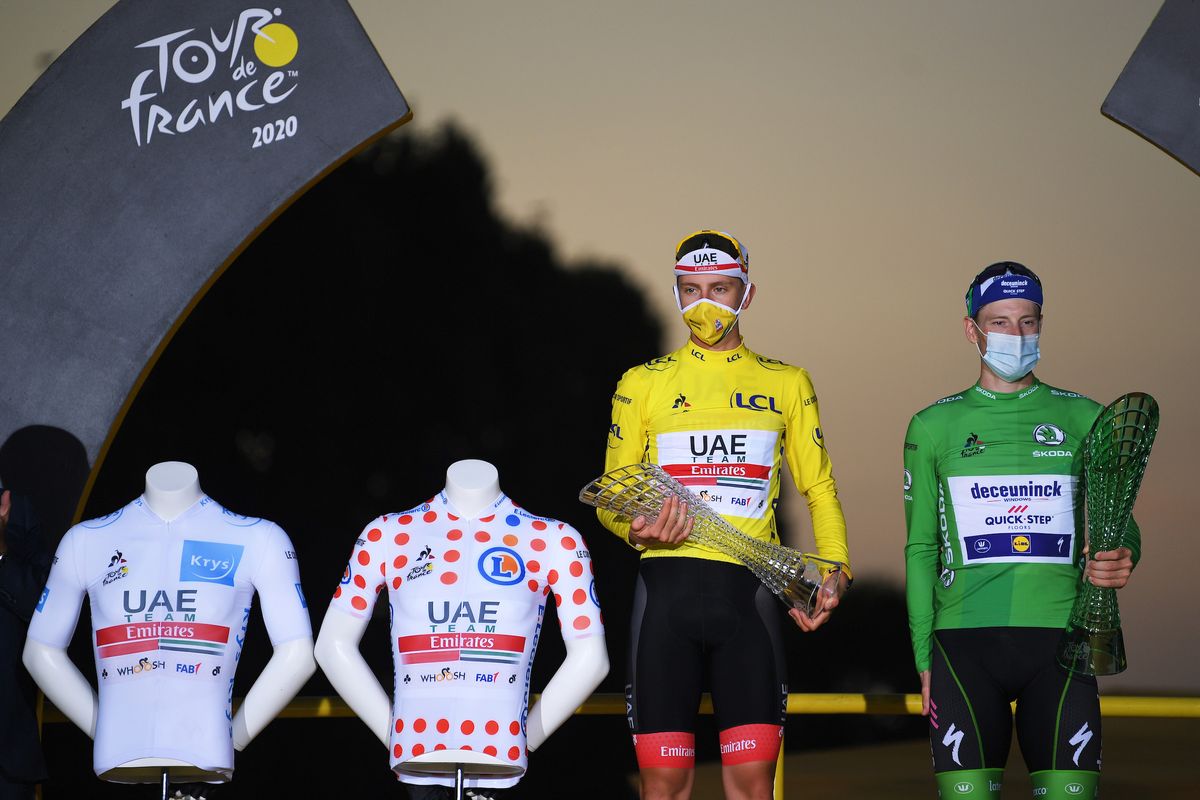Products You May Like
The Tour de France sees the very best cyclists in the world battle it out for the yellow, green, white and polka-dot jerseys, based on the general, points, mountains and young rider classifications.
The jersey for each category is awarded to the leader of that classification at the end of every stage, and the recipient earns the right to wear it during the following day’s racing.
Here we take a brief look at what they are and how they are won.

(Image credit: Photo by Luka Dakskobler/SOPA Images/LightRocket via Getty Images))
Tour de France jerseys: Yellow – overall classification leader
Also called the maillot jaune, the Tour de France yellow jersey is the most coveted item of clothing in professional cycling. The wearer is the rider who has completed the race in the least amount of time, and as such tops the overall or general classification (GC) of the race.
In recent years, Tadej Pogačar (UAE Team Emirates) has dominated the GC, with the Slovenian seen wearing the yellow jersey for a number of stages as he went onto win both the 2020 and 2021 editions of the race.
Before that, in 2012, Bradley Wiggins became the first British rider to finish in Paris in the Yellow Jersey – with Chris Froome following up in 2013, 2015-2017. Geraint Thomas took the 2018 race, with Colombian Egan Bernal winning in 2019.
Last 10 winners of the Tour de France general classification:
Tour de France jerseys: Green – points classification leader

(Image credit: Getty Images)
The green jersey relates to points awarded to riders according to the position they finish on each stage, with additional points for intermediate sprints during some stages also on offer.
The number of points on offer will vary depending upon the type of stage. More are on offer during pure flat, sprint days, while on hilly and mountain stages there are fewer points available. The points are then tallied up after each stage and added to points won in all previous stages. The green jersey (maillot vert) is awarded to the rider with the most points.
The jersey took its colour because the initial sponsor was a lawn mower manufacturer – though the colour was changed once in 1968 to accommodate a sponsor.
Both Eddy Merckx and Bernard Hinault successfully won both the general classification and the points classification with Merckx achieving the biggest sweep in 1969 with the points, mountain and general classifications to his name. Over the last ten years, Peter Sagan has triumphed in the points classification on no less than seven occasions.
Last 10 winners of the Tour de France points classification:
Tour de France jerseys: Polka-dot – King of the Mountains classification leader

(Image credit: Getty Images)
Mountains points are awarded to riders who manage to summit classified climbs first. Points vary depending on the category of each ascent, with more difficult climbs awarding more mountains points.
Climbs are divided into five categories: 1 (most difficult) to 4 (least difficult) – then there’s the ‘Hors Categorie’, denoted by HC which represents the most challenging of ascents. The tougher the category, the further down the standings the points reach – a HC climb will see points awarded down to the first eight over the summit, while a fourth category climb results in points for just the first rider over the top.
The organisers decide which mountains or climbs will be included in the competition, and which category they fall into. If the stage features a summit finish, the points for the climb are doubled.
The points are tallied up after each stage and added to points won in all previous stages. The distinctive white-with-red-dots jersey (maillot à pois rouges) is given to the rider with the most mountains points. The first climber’s award was given out in 1933, and the jersey arrived on the scene in 1975.
Last 10 winners of the Tour de France mountains classification:
Tour de France jerseys: White – Best young rider classification leader

(Image credit: Getty Images)
The plain white, young rider classification jersey is awarded to the fastest under-26 rider at the Tour de France.
First introduced in 1975, riders such as Marco Pantani, Alberto Contador, Egan Bernal and Tadej Pogačar have all won the young rider classification, helping propel them onto bigger and better things during their careers.
Last 10 winners of the Tour de France young rider classification:
Non-jersey classifications: combativity and team competition
There are two further classifications that do not earn the winner(s) a coloured jersey – the Combativity Award and Team Classification.
While not necessarily a classification, the Combativity Award is given to the rider who has shown the most fighting spirit during each individual stage, as chosen by the race jury. They wear a red race number during the following day’s stage. A ‘Super Combativity’ award is handed out on the final stage for the most aggressive rider during the whole race.
The Team Classification is based on the collective time of the three highest-placed riders from each squad. Leaders of the team classification get to wear race numbers that are yellow with black digits, and the right to wear yellow helmets. The latter is not compulsory.
